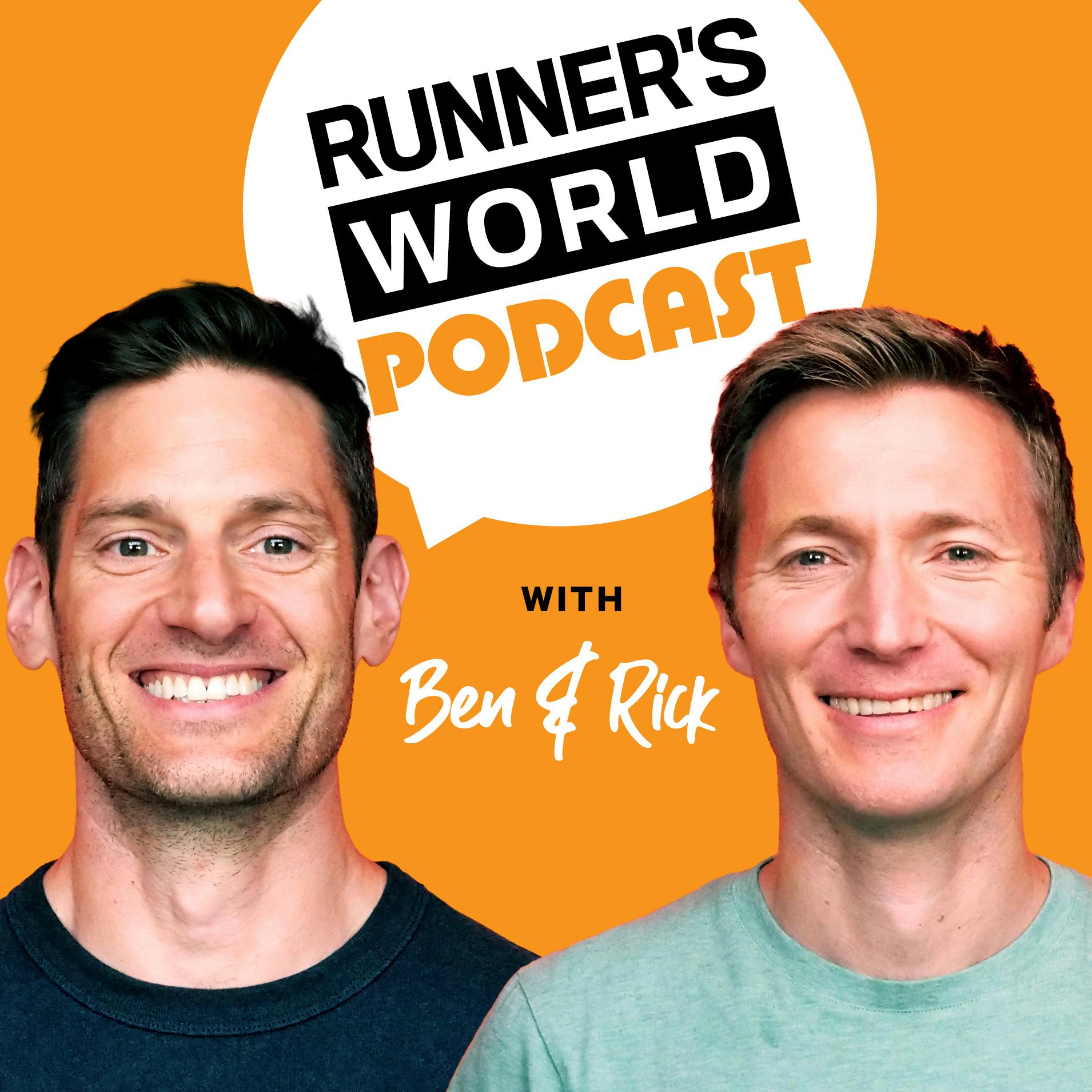
Brian's Run Pod
Welcome to Brian's Run Pod, the podcast where we lace up our running shoes and explore the exhilarating world of running. Whether you're a seasoned marathoner, a casual jogger, or just thinking about taking your first stride, this podcast is your ultimate companion on your running journey.
Join us as we dive deep into the sport of running, covering everything from training tips and race strategies to personal stories and inspiring interviews with runners from all walks of life. Whether you're looking to improve your race times, stay motivated, or simply enjoy the therapeutic rhythm of running, Brian's Run Pod has something for every runner.
Brian's Run Pod
Run Like A Pro: Conversations with Andrew Wren Pt 2
Ever wonder how to find your stride and truly enjoy the thrill of running? We're thrilled to have professional running coach, Andrew Wren, join us to share his insights and expertise on this. Together, we unravel the art of running - from the basics to the little-known strategies that can take your performance to a whole new level. We also explore the controversial topic of cadence running and why it might not be the best approach for beginners. Andrew highlights the criticality of building a symbiotic relationship with your coach and cautions against hasty changes that could end up backfiring.
In the second half of our conversation, Andrew turns the spotlight on an aspect of training that's often underestimated - interval training. Discover how speed and tempo intervals could revolutionize your body's functioning and why they're beneficial for runners across all proficiency levels. We delve into the importance of exercising different muscles in novel ways to circumvent injuries. Andrew also deciphers some complex running training jargon, pinpoints the differences between British and American coaching styles, and lays out the nuances of lactic threshold measurement and tempo running. Don't miss this episode filled with invaluable insights and actionable tips that will significantly level up your running game.
https://www.runwolves.com
Lucy Tomlinson Christmas Offer for Welcome Pilates
Brian's Run Pod has become interactive with the audience. If you look at the top of the Episode description tap on "Send us a Text Message". You can tell me what you think of the episode or alternatively what you would like covered. If your lucky I might even read them out on the podcast.
Instagram
So you're thinking about running but not sure how to take the first step. My name's Brian Patterson and I'm here to help, and welcome to Brian's Rompod. Well, welcome back to Brian's Rompod In this second part of an interview I did with Andrew Wren, who is a professional running coach in the Teddington area. He starts by explaining how he approaches training a beginner. If you haven't listened to the first episode, please do. I found talking to Andrew extremely inspiring and very informative. I really do hope you enjoy this part of the discussion as much as I did. Over to you, andrew.
Paul:Someone who comes to me with no event in mind and just says, okay, i want to run, for I want to learn to run properly. that's a joy, a genuine joy, because we'll do everything right. I'll teach them how to sprint, i'll teach them how to run long distances, i'll teach them how to run up and down hills. There's so much stuff because you can just use the joy that we have for running and just just take that and just hand it to them.
Brian:It's magic Yeah yeah, i mean just, you just prompted something, a question in my head and that, and something I'm becoming more acutely aware of now. Okay, not just because I've been doing this podcast or whatever, but I do see some people and I'm just, i'm just filled with jealousy because I could just run. I wish I could run like them, because the way they run is it just either? there's kind of this effortless ease and relaxation and they just seem to be enjoying it more, whereas someone like me I don't know it just seems to be something I would say that's what makes you a runner.
Paul:I would say, having the feeling of that is what actually makes you a runner, because everyone feels like that on every level at some stage. Now I guess I feel like that. I live close. I live in Tedington, south West London. I live quite close to a sports university, i don't know why. I'm pointing it to you, pointing out to you So, occasionally, the same areas indeed, and there are often sort of 18, 19 year olds come gliding past me, like you know, they occasionally tap the ground to check it's still there. As they go past, you know, and like that sort of stuff, and I look at them and I just think, wow, you know, that's incredible, right, but like on other days, i'm that person to somebody else. On other days there's somebody else who I was. That is that inspiration, right. So, like from Usain Bolt and Kip Chogy down, we have, like everyone has this layer of being the sort of to make it sound possibly a bit too preposterous, but like the sort of inspiration to somebody else. So I would say, though, it's important to actually be able to find the times when you do feel really in a sort of in a flow with running. It's quite easy.
Paul:From a coaching perspective. One thing that I find myself doing is telling people that they that their natural pace is not the pace that they should be running at, because most a lot of people just go out and they just run right. A lot of people, like a lot of people, will do that. There's no plan, they just go out and they run. There's nothing wrong with that. But often There's no need for that. Often there's no need to just go and run, like sometimes it'll be too fast to build, to build their endurance without adding too much fatigue. It's not fast enough to add speed. It's not fast enough to actually be a tempo run. So if I was doing it purely on a clinical basis, i would just rule that sort of thing out. But realistically, he can't strip the joy from someone's running. That's not helpful to anybody. So, yeah, it's important to, like you alluded to at the start, it's important to have the coaching as a collaborative process where both people are involved, not just me dictating to someone.
Brian:What do you think about because I've heard it sort of banded about about this sort of cadence running that you should be running at this optimum SPM, you know, like 180, whatever you know It's. You know, for some people that may not be possible, but is it something that? is that something for beginners? Obviously, people who are at an elite level they can do that, But no, it's not something we should be.
Paul:In simple terms, no, in there's a lot of this running. There's a lot of this in the fitness industry. It's essentially sort of simple answers to complex questions. There are lots of people who run at too low a cadence. There are very few people who run at too high a cadence. But the problem is that fixing cadence or adjusting cadence that way to put it could well have, and almost certainly will have, knock on effects elsewhere. So if you increase your cadence, there's an extremely high likelihood that your foot strike will change slightly. There's an extremely high likelihood that you'll add more stiffness into your body unnecessary stiffness because you're because running is a very rhythmic movement. So if you change the rhythm or you change the tempo more than the point, if you change the tempo, then it's going to fundamentally change the way that your body works And it's going to have knock on effects. So, from a pure basis, if you went from running at 160, 160 cadence to going out the next day and running at 180, there's an extremely high likelihood that it would have negative side effects.
Brian:Now, you just wouldn't enjoy it.
Paul:Well, no, you wouldn't enjoy it.
Brian:It would be weird.
Paul:And whenever people change the cadence it feels really strange When I get people. I actually did work on cadence literally yesterday with someone And I only do it through sprinting. It's the only time we do it. I don't do it. I use sprinting as a drill quite often. It's one of the things that I use quite a lot. I use sprinting as drills because I find that if you can put the thing that you're wanting someone to do into sprinting, it actually applies better to running rather than just doing it as a drill, rather than doing it as a skip or as a standing drill or something like that. I find that if I can apply it into sprinting, it actually carries over in a slightly more fluid way.
Paul:So what we were doing yesterday was we had three trees in the park well, four actually, because we were stood next to one at the start. So from the start to the first tree, we'd focus on cadence. So tippy, tapping our feet I had a metronome We're going at 200. So 200 from the first tree. So from the first tree to the second tree And then the second tree to the third tree, we would focus on relaxing our bottom lip, so ensuring that we shed any tension that we'd added into our body by increasing the cadence, interesting, interesting. So from tree three to tree four, we'd focus on lifting our knees up to accelerate again. And that essentially mimics how you would race 200 meters, in that you would accelerate and then you would float and then you would accelerate again. But what I was able to do there was able to essentially coach three different things in the same action. Because when you try and increase cadence, it's a good time to actually try and reduce tension, because you add a lot of tension into your body. So you're putting someone in a position where they can really feel tense and then get them to relax. Yeah, so it can be a useful thing to coach, but not always. It's usually something that you would coach when you were trying to eradicate something more obviously negative.
Paul:So some people and this is extremely prevalent among triathletes in my experience is that they will, because cycling cadence is about 100 or so. They're quite used to putting out big power in sort of ploddy kind of cadence. So you'll find that when they sprint, running is really simple maths when you think about it. It's the amount of power that you can put out times by the amount of times you hit the ground. It's as simple as that. Now, if you ask someone to accelerate, if their cadence is super low, they're not going to increase the number of footsteps, barely at all, but they're going to increase the power a great deal. Now that's going to mean that there's some real problems with efficiency. So in that instance, yeah, you would want to increase someone's cadence. But if someone is an ultra marathon and they race 100K ultras, that's the main thing that they do the power that they're putting out with each, with each sort of foot stroke, for example, it's just not going to be a huge issue for them to run at 160 170. So it really does depend on the person. It really depends on the running style. I Will sometimes train cadence in order to stop people from overstriding, but, like, fundamentally, i don't know This is going to be a bit of a left field shout on this one.
Paul:People will probably be aware of the cricket at Jimmy Anderson. Yes, jimmy Anderson had a very specific action in like 2004, 2005, and they tried to change his action because they wanted him to be a certain thing. Right, they thought he could be a certain type of bowler and whereas actually Changing his action just made him worse, right, it didn't. It didn't make him better, in a kind of way. So it wasn't until he Sort of retreated back to where he'd used to be Yeah, but he actually became one of the greatest test bowlers of all time, right and Yeah.
Brian:So so I often find that taking a sort of lower intervention Stance and some things is quite useful, because the changes you could make further down the line are potentially worse than the things that you start off with and I suppose, from going from what you're saying is that you're as, let's say, as a beginner, that as they become Fitter or, you know, get used to running The, the cadence part of it will be as a byproduct into that in terms of that will Be kind of a natural evolution. You know it may or may.
Paul:Increase. you know it's like they are getting stronger and yeah, yeah, yeah, absolutely Yeah. It's certainly not something I would worry about with beginners ever. No, you're right, probably not even in the first year of running.
Brian:What do you say to, i mean explaining, to, let's say, beginning about, i mean, i know you, you touched on You know you're doing a speed session, about doing interval training. I mean, how would you, you know, explain? you said, well, you know someone's come, i've come to to you and and let's say I'm going to be running a 10k for You know as a particular thing. and I said, well, you know, i hear a lot about Speed training, how you know interval training, how can that help me? Hmm, well, how would? how would you kind of, or would you say, i mean, there are, there are.
Paul:So there are. There are five facets of running fitness. I'm gonna forget one. It's gonna be brilliant. Yeah, coordination, flexibility, yeah, speed.
Paul:Strength, endurance right, endurance is the one that all of my athletes are training. There's absolutely no, no question about that. Obviously, i care about it a lot, but it's it's like everyone who comes to me wants to train their endurance. Flexibility, you know separate, but speed and strengths two of the five, right.
Paul:So now people might not necessarily think that speed is well. In fact, a lot of people will try and self-deprecate themselves through the floor when I speak to them. Oh, i'm not very fast now, i'm very slow, i'm not mad, and I think people are overly defensive about that, because a large makeup of your muscle fibers will be fast-tritch muscle fibers. So learning to actually use those muscle fibers is going to be extremely useful for every type of runner. Otherwise, you're only utilizing a proportion, whatever portion that is. Some people will have more slow-tritch, they'll have more fast-tritch, etc. But from a fundamental perspective, it's a more rounded way of using your muscle fibers. So that's on the micro level, but on a macro level, the way that you move your legs when you do speed work or sprint work or tempo intervals, whatever they are, is slightly different to the way that you use your legs and your body when you do your long runs. So if you're a new runner especially beginners actually, this is especially relevant to beginners if you're a brand new runner and you're just plowing the same movement through your body, you're using your calves, you're likely to be massively overusing your calves. You know, honestly, your calves, your quads, your hamstrings, your glutes, using them in exactly the same way, over and over and over and over again. That's the kind of thing that can cause issues with your body, whereas if you start to do some slightly different movements, by which I mean either running super fast or running a little bit faster, it's going to change that, the way that you use your body, meaning that you're not just making the exactly the same movement each time. Like, for example, like if you were going to the gym and you were going to train arms, you wouldn't just do the same exercise for an hour, right, you wouldn't just just sit there and do sort of bicep curls for the same hour And there's, you know, a similar number of muscles in the arm as there is in the leg. So it's about utilizing the body in in slightly different ways so that people don't get issues Because what can happen? Now, i think this is a bad perception, necessarily, but I understand where it comes from people that think that runners get bad knees And runners do get bad knees.
Paul:I mean it's a fair point. It's not necessarily just the running that's the problem, though it tends to be bad knees. I mean, knees are just knees, are just bone, right, nothing's. Nothing's actually going wrong in the knee itself. It's it's being pulled in either direction by the three muscles which connect to it. Yeah, and if you overuse the calf, then you're pulling too much in that direction. Or if you were to overuse the quad, you'd be pulling too much in that direction.
Paul:So your joints will be helped by running running fast as well as running slow, because the likelihood is that when you run fast you bring your knees up more and you utilize your quads and your hamstrings. Now, from a purely health perspective, there's there are a lot of health benefits as we get older to doing sort of higher impact exercise because it strengthens your bones. So you know, there's that as well. There's the aspect of like, but our muscles also waste a little bit more as we get older. So actually using them in a bit more of an even more eccentric way, then it's a useful thing to do.
Brian:And also does speed work translate to a better aerobic capacity?
Paul:Yeah, absolutely. I mean, if you're, the more you open up your lungs, the more you can open up your lungs in future, right, right, Like, from a purely aerobic capacity. yeah, the zone to zone to endurance work, so the easy runs, the long runs, whatever, primarily, the so primarily work in terms of you know processing fat and in terms of you know using the heart as a muscle. right, yeah, like, yeah, there isn't a aerobic component, like it would be. it would be childish to say that there isn't but you're going to open up more parts of your lungs by running super fast and you're going to increase your sort of VO2 max is called VO2 max for a reason. right, yeah, it's not the VO2 min, right? So, yeah, there are, but, like, it will certainly help you aerobically but the that's so there's different stages at different points. right, because if you take base sort of zone to endurance, skip zone three because we don't really need it.
Paul:zone four is sort of just below your 10k pace And that's useful because it's it's helping to move up your lactic threshold. Yeah, so that the faster you can get your lactic threshold, the faster you'll be able to get your 10k. We haven't even talked about that. I think yeah, yeah, exactly yeah, and then. but then speed work is going to, if you do it properly, get controversial on that. If you do it properly, you're going to increase your overall top end speed.
Brian:Yeah, Okay, Okay, And I mean touching on that because I know we did talk about some, you know, like tempo running do people get confused with like tempo running and that lactic threshold? Yeah, Or is it one? and yeah, I thought you might say that. So so what would it?
Paul:explain The terminology. Yeah, the terminology is all quite woolly and it gets used in different ways by British coaches and American coaches and it gets used in different ways by cycle coaches and by running coaches. In cycling, tempo is zone three And in running we would never use zone three. So that's, that's going to sound quite mystified to a lot of people, but essentially zone four is just below your 10k pace. Yeah, so if you measure your lactic threshold to be your 10k pace, then your then zone four tempo.
Paul:Now, tempo can be called tempo, it can be called threshold, it can be called muscular endurance. You would. Those would tend to be defined by how long the intervals are rather than by what the actual speed is. Now, you can. There are lots and lots of different ways to skim this particular cap, but specifically you can. You can do it by going over and under your lactic threshold within the same run. You can do it by staying 10 seconds per kilometer slower for the entire run or for 10 minute intervals, or whatever it is. Fundamentally, they're all doing relatively similar jobs. So if you hear threshold run, tempo runs, tempo runs tend to be maybe slightly slower and more steady state, but that's purely nomenclature. There's no, there's no real difference in terms of what the function of the run is for. So like if you're doing a anything around under 10k pace or maybe just over 10k pace, the design of the run is intended to improve lactic threshold. Yeah.
Brian:Okay, fundamentally, yeah, okay Yeah.
Podcasts we love
Check out these other fine podcasts recommended by us, not an algorithm.

Life Changing
BBC Radio 4
Tech Life
BBC World Service
Runner's World Podcast
Runner's World UK
Buzzcast
Buzzsprout
Newscast
BBC News
Understand
BBC Radio 4
Cyber Hack
BBC World Service
Ghost Story
Wondery | Pineapple Street StudiosDiz Runs Radio: Running, Life, & Everything In Between
Join Denny Krahe, AKA Diz, as he talks with a variety of runners about running, life, and everything in between.
Uncharted with Hannah Fry
BBC Radio 4
The Global Story
BBC World Service
The Coming Storm
BBC Radio 4
Lives Less Ordinary
BBC World Service
Do Epic Shit Today Podcast
Hannah Mulhern
The Rest Is History
Goalhanger
